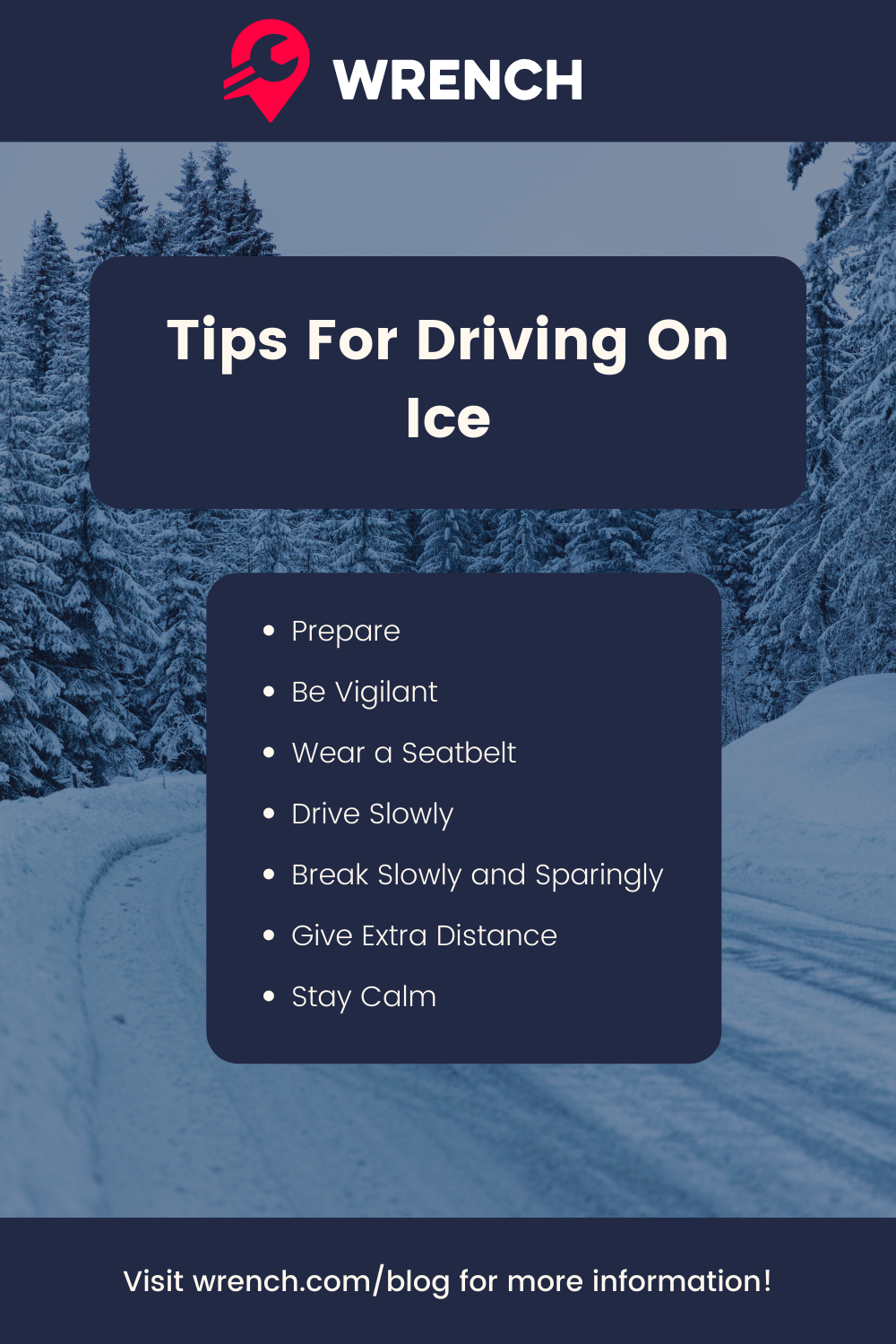As kids, many of us remember the excitement of snow days. Fingers crossed, going to sleep, hoping for school to be canceled. But once you start driving, you are bound to dread the cold weather when it provides icy roads unless you are prepared for driving on the ice. As many prepare for the winter months, and some are already experiencing the extreme effects of the cold, it is essential to acknowledge the risk that icy roadways pose to drivers. It is always important to prepare for unexpected or unsafe factors while driving, as emergencies should always be prepared for. Knowing what to do to decrease your risk of accidents during cold conditions is crucial as it allows you to have additional tools to ensure the safety of you and other drivers in unsafe conditions.
Get a free quote
8 Tips for Driving in Icy Conditions
1. Prepare:
Good winter tires and having chains available can reduce the risk of a severe accident on icy roadways. In addition, these items increase the traction that your vehicle can get on slick roads, making it easier to maintain control while you drive.
2. Be Vigilant:
Being vigilant of the weather, in addition to road conditions, will help you prepare for dangerous roadways. It is crucial not to rely on the car thermometer when it comes to expecting ice solely. The air temperature warms more quickly than pavement, suggesting that the ground is still frozen even if the car temperature is reading above freezing. Black ice can be challenging to notice on roadways as it often resembles puddles. This is yet another reason why it is essential to follow the weather and be aware of your surroundings and road conditions. A warning of an icy road can include frost on the windshield, ice on the windshield wipers, side mirrors, road signs, or another surrounding object.
3. Be Alert Of Changing Surroundings:
A rise in elevation or a drop in temperature while driving can quickly produce icy roadways. Being alert of these changes enables you to adjust your speed and driving to ensure your safety.
4. Wear Your Seatbelt:
With the increased risk of an accident, you, and anyone in your vehicle, need to wear a seatbelt.
5. Drive Slowly:
Driving slowly in icy conditions allows you to control the vehicle and maintain traction, decreasing the chance of a slide. If you do lose control, the slower speed of your car increases your chance of regaining traction, slowing the car, and recovering control, in addition to reducing the risk of an accident.
6. Break Slowly And Sparingly:
Reducing breaking and doing so gradually reduces the chance of a slide. Often breaking can cause the car to lose control as it cannot maintain traction on the slick surface. In addition, abrupt actions like braking put you and your vehicle at risk because the force applied to the brakes is greater than the force between the tire and the roadway. As a result, braking can trigger a slide or worsen an existing drift.
7. Increase The Following Distance Between You And The Car In Front Of You:
it takes nearly ten times the stopping distance to stop on a snow-covered or icy roadway than it does on dry pavement. Therefore, using caution and increasing the distance between cars helps reduce the chance of an accident or damage to you or your vehicle.
8. Stay Calm:
Maintaining a calm and collected mindset allows you to not act out of stress or fear. In addition, a temperate attitude increases your and your car's safety by reducing sudden and bold reactions to road conditions. Overcompensating or freezing up in icy conditions is the most dangerous thing you can do. Quick and careless responses put the most risk on you and your vehicle because of the reduced traction caused by snow or ice.
6 Tips To Avoid When Driving In Icy Conditions
1.Don't Drive Unless Necessary:
Reducing your car trips when the roadway is icy is the best way to avoid accidents in cold weather. Drive only when essential. If possible, monitoring the temperature when planning longer drives will help you prepare or adjust for extended travel within icy conditions. The only way to entirely reduce your risk of an accident caused by snow or ice is to avoid driving when freezing temperatures are present.
2. Avoid Driving At Night And Early Morning:
Both of these times increase the chance of ice or snow because of the lowered temperature. Additionally, they offer reduced visibility on the roadways.
3. Do Not Drive Fast:
A good rule of thumb is not exceeding 45 mph on any roadway, including highways, when freezing conditions are present. Driving above this speed makes it more challenging to stop and much more likely to lose control of the car.
4. Don't Be Overly Confident:
Although confidence as a driver is learned and taught, it is essential never to be exceedingly confident in dangerous road conditions. A sense of certainty is what causes a large portion of accidents. Even with experience driving on icy roads, any individual can find themself in an out-of-control vehicle that lost traction because of the roadway conditions. Even four-wheel-drive cars have highly reduced control on icy roadways. In addition, four-wheel or all-wheel vehicles do not necessarily drive substantially better than that of a two-wheel-drive cars, putting you at risk in whatever vehicle you are driving. It is essential to acknowledge the risk of driving on icy roadways and the unpredictable factors that accompany freezing temperatures—using caution while in these situations is critical to maintaining control of your vehicle.
5. Don't Use Cruise Control:
It is essential always to avoid cruise control in icy conditions. Cruise control can cause the wheels of your vehicle to spin at different speeds, which puts you at risk of losing control in freezing conditions. Cruise control also increases your chance of driving at an accelerated rate, despite the conditions requiring a slower-paced trip.
6. Unless Necessary, Don't Drive On Hills:
Steep inclines are nearly impossible to hold traction on when the roadway has ice or snow. In addition, avoiding hills will decrease your chances of losing control.

If you do lose control of your vehicle while driving on icy roadways...
Sometimes losing control of icy roadways is inevitable. It is essential to stay calm if this happens. Do not immediately slam on the brakes or overreact in other ways, as this will result in you and your car being totally out of control. At the first sign of losing traction, take your foot off the acceleration. Do not accelerate until you have regained complete control of the vehicle. Accelerating will cause the wheels to spin, which you do not want when you do not have control. It is okay to pump the brakes lightly to slow the vehicle. Do not brake too hard or quickly, as it will create or worsen an existing slide. Steer away from the drift, but do not oversteer. Oversteering will result in a further loss of control and possibly cause your vehicle to spin more. By steering away from the spin, you can correct the vehicle's orientation. Steering away from the spin is done by noticing the direction your car is turning and turning in the opposite direction. All of these steps, if used correctly, will enable you to regain control of the vehicle safely.
Preparing your car for winter has never been easier. Wrench offers mobile mechanics to help guarantee you stand your best chances against cold temperatures and icy roadways. It is always best to prepare for the worst and hope for the best, and Wrench is ready to help you prepare wherever is easiest for you!
Wrench is now offering a winter maintenance package for your vehicle for a limited time only. This package includes an oil and filter change, tire rotation, new wiper blades, battery inspection, brake inspection, air filter installation, cabin air filter installation, and a 22-point visual inspection. This limited package makes it easier than ever to prepare for winter and the harsh conditions you and your car may face. So book an appointment today to get a quote and schedule a winter maintenance package!
Get a free quote


